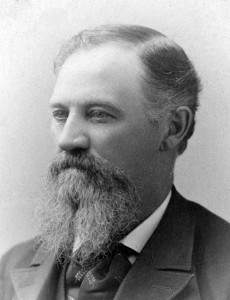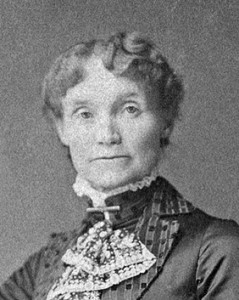Littleton History: Biographies, Chatfield Family
CHATFIELD FAMILY
Isaac Willard Chatfield
The gold rush to the Rocky Mountains brought people who wished to prospect in land as
well as gold. Isaac “I.W.” Willard Chatfield (age 23) and his wife, Eliza Ann Harrington (age 19) traveled by wagon train from Bath, Illinois, to Denver in 1859. Disillusioned by the overcrowded and primitive conditions, plus the lack of viable claim opportunities, the young couple soon moved east to Kansas where they settled on a 160-acre squatter’s claim 12 miles north of Fort Scott in Bourbon County. It was there that their first child, Ella (destined to become one of Colorado’s most talented sopranos) was born.
With the polarization kindled by the Kansas-Nebraska Act and impending Civil War, Isaac and family fled Kansas, returning to their former home in Bath, Illinois. When war erupted Isaac enlisted in the Union Army’s 27th Illinois Infantry, where he rose to the rank of lieutenant in Company “E” before illness forced his mustering out in 1863. It was then that he, accompanied by his wife, daughter Ella, sister Ellen, and Robert Marr Wright (Eliza’s cousin) traveled for 8 weeks by ox cart and horses to today’s Florence, Colorado, where they eventually settled on a homestead of 160 acres. Isaac raised cattle in Florence, an endeavor quickly bringing him great fortune. By 1870, he had expanded his ranch to 320 acres. In early June, Isaac sold his 320-acre ranch to James McCandles for $5,000 cash, 100 steers at $35 a head, and the Spring Ranch valued at $1,500. The land was subdivided into what is now the town of Florence, honoring McCandles’ daughter. Oil was later found nearby.
In 1871, Isaac moved his family 100 miles due north to Arapahoe County, just south of Littleton, having purchased J.B. Hendy’s 160-acre ranch situated at the confluence of the South Platte River and Plum Creek. By 1874, Isaac had expanded his ranch to 720 acres—a huge spread stretching north to encompass the junction of the Platte and Bear Creek River—land Isaac had purchased from Dan Witter, a Denver lawyer and surveyor. During these same several years, Isaac persuaded the Colorado and Central Railroad to establish a station on the narrow-gage spur connecting Littleton to Denver and the East, lucrative and safe for shipping cattle. The small stop at Milepost 14.07 on Chatfield’s property was named Chatfield Station. Diversifying, Isaac increased his profits by introducing the practice of growing and shipping potatoes.
By 1873, Littleton had become a thriving town, a magnificent 35,000-acre agricultural center supporting more than a dozen farms, bounded by the Platte River on two sides, Bear Creek and the foothills. From Bradford Hill could be seen 17 lakes (varying from 10 to 200 acres) formed from ditches cut for water distribution over the last decade. It was during this time that Isaac became a major investor in the Last Chance Ditch Company on the Platte River. The dense cottonwoods lining the ditch netted Isaac and other investors $9.48 per acre.
Meanwhile, Isaac W. Chatfield continued his cattle, potato, and water operations, increasing his control of the Last Chance Ditch Company to 1/3 by 1878, his stock entitling him to 250 inches of water annually. Even so, by 1879, Isaac’s income was tapering; the cattle market was shifting progressively west, and Leadville, just 98 miles southwest by wagon, was rocking the public with news of silver strikes at Iron Hill, Fryer Hills and Carbonate City—a lure that Isaac found impossible to resist. The business opportunities seemed limitless: railroad contracting, grocery store ownership, mining interests, livery and saloon ownership, commercial investment and even politics. He would not return to Littleton but would hold onto his stock in the Last Chance Ditch Company and retain a home on Marion Street in Denver where the children would attend school and vacation with their mother over the summer months.
Isaac then moved the family to Leadville and worked in the railroad contract business. He also acquired shares of two silver mines: the Late Acquisition and the Smuggler #2. Soon, he partnered with Joseph Brinker, Jr. in a grocery store named Brinker & Chatfield. The grocery business proved successful, especially for miners’ provisions. Isaac, who often toyed with political aspirations, was elected as a city alderman in 1880. Chatfield and Brinker took on another business partner, Albert Wheeler of New York, in 1881, but this arrangement was dissolved in 1882. A new associate named Wing joined the business in 1882, and the business name changed to Chatfield & Wing.
Isaac and Eliza had nine children: Ella, Clark (died at birth), Elmer, Phil Van Wert (died at age 17), Jacqueline, Charles, Myrtle (died age 3), Grace (died at birth), and Calla. Wert, Myrtle and Grace were all buried in the Littleton Cemetery. Ella became a well-known soprano in Leadville and performed at the local opera house built by Horace Tabor. Elmer worked in his father’s grocery store. In 1886, Isaac sold the grocery store to Theodore Blohm Merchandise Company. He returned to cattle raising, buying ranches in Rio Blanco County. Elmer started his own cattle ranch at Emma, Colorado.
Isaac Chatfield and his family eventually moved away from Leadville, settling in Emma, a short distance away from his son Elmer’s ranch. Isaac was elected to Colorado’s House of Representatives in 1889. However, his bid for state senator in 1896 failed. He returned to Denver in 1899 and later joined the W.E. Moses Realty Company in 1906, becoming the vice president in 1908. Isaac and Eliza celebrated their fiftieth wedding anniversary on May 20, 1908. Eliza died on June 12, 1911, of uterine cancer at the age of 71 in Basin, Big Horn County, Wyoming. On August 30, 1913, Isaac married Sarah Jane (Rooker) Wisenor in Oakland, California. Isaac died on June 14, 1921, at the age of 84, in San Jose, California, the causes of death included arteriosclerosis, chronic cystitis, and other internal maladies associated with the Civil War. He was buried in the GAR veteran’s section of the Oak Hill Cemetery in San Jose.
Source: http://www.littletongov.org/history/biographies/chatfield.asp

